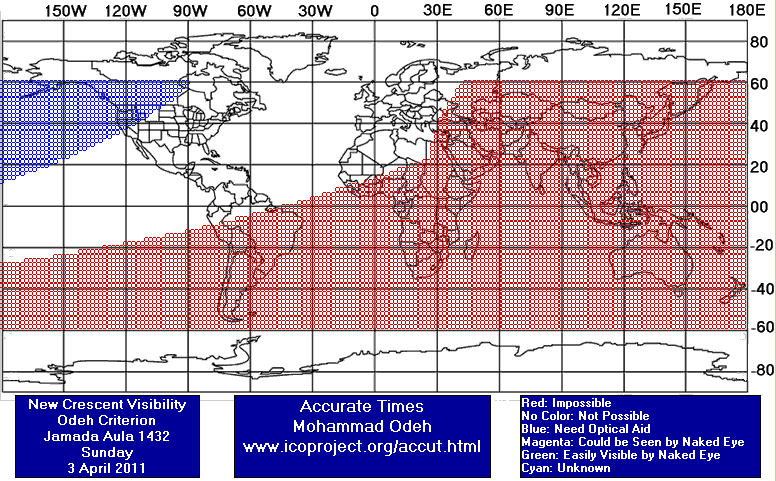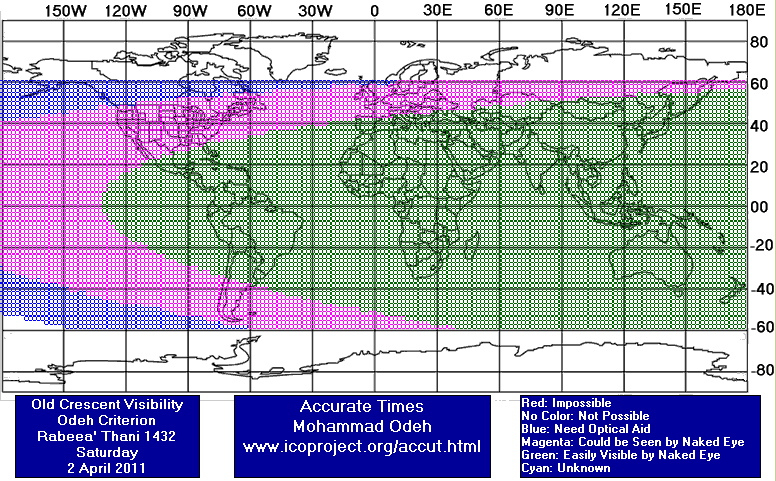Visibility of Jumadal Al-Aula Crescent 1432 AH
- When to Observe Jumadal Al-Aula Waxing (NEW) Crescent ?
- Jumadal Al-Aula Waxing (NEW) Crescent Observation Results
- The OFFICIAL First Day in Different Countries
- When to Observe Rabee' Al-Aakher Waning (OLD) Crescent ?
- Rabee' Al-Aakher Waning (OLD) Crescent Observation Results
When to Observe Jumadal Al-Aula Waxing (NEW) Crescent ?
The geocentric conjunction (Geocentric New Moon) will occur Inshalla on (Sunday 03 April 2011) at 14:32 UT.
Sighting the new crescent on (Sunday 03 April 2011) and (Monday 04 April 2011) is shown in the below graphs using the program Accurate Times by Mohammad Odeh according to Odeh criterion. Where:-
- It is impossible to see the crescent from the areas located under the red color. Because either the Moon on this day sets before the Sunset and/or the topocentric conjunction occurs after the Sunset.
- The crescent is expected to be seen by optical aid only from the areas located under the blue color.
- The crescent is expected to be seen by optical aid from the areas located under the magenta color. In these areas the crescent could be seen by naked eye if the atmospheric conditions are superb and the observer is experienced.
- The crescent is expected to be easily visible by naked eye from the areas located under the green color.
- The crescent cannot be seen from uncolored areas, even though the Moon sets in these locations after the Sunset and the topocentric conjunction occurs before the Sunset, but the Moon is not sufficiently illuminated in order to be seen as crescent even by optical aid.
- Kindly notice that the below graph shows the possibility of seeing the crescent from areas between 60 degrees north of Equator down to 60 degrees south of Equator.


According to the Universal Hejric Calendar (UHC), which is based on the calculated crescent visibility, the start of this month in the Eastern Region will be on Tuesday 05 April 2011 and in the Western Region will be on Monday 04 April 2011. Kindly notice that the UHC is a pre-calculated calendar, which adopts a certain criterion to start the new Hejric month. Your country/organization might adopt different criterion to start the new Hejric month. So it is highly advised to read the UHC website before giving any judgment.
- Results of seeing the crescent, and the first day of the month in different countries will be added here Inshalla as we receive the reports from ICOP's members. If you wish to be a member in ICOP, or to know more about it, kindly click here.
Jumadal Al-Aula Waxing (NEW) Crescent Observation Results
Sun 03 April 2011
Nigeria
Mr. Usman Dukku said: "Because it was cloudy and dusty, we did not attempt sighting the crescent."
United Kingdom
Eng. Qamar Uddin said: "On Sunday 3 April 2011 (29 Rabi-ul Thani 1432 AH) many people from throughout UK have attempted to sight the crescent moon (Hilal) of Jumada Al-Awwal after sunset. None of the groups were able to sight the Hilal, even though some places had clear sky conditions near sunset positions (see attached photos). We have not received any reliable sighting news from countries east of UK or Morocco either. Message from Professor Abdelkhalek Cheddadi stated official decision by Morocco Awqaf Ministry is negative sighting. Therefore, the Ulama (including Wifaq/Batley) have decided that the month of Rabi-ul Thani 1432 AH will complete 30 days and the month of Jumada Al-Awwal 1432 AH will start from Tuesday 5 April 2011, Insha-Allah. "
Mon 04 April 2011
Algeria
Mr. Hocine Chikh Aissa said: "11 persons were present in N'tissa station .The new crescent of Jumadal Awwal 1432 was seen by naked eyes. "
Bangladesh
Mr. ABM Ruhul Hassan said: "Moon was not seen because the sky was very cloudy."
Germany
Iran
Malaysia
Nigeria
Mr. Abdul-Rasaq Abdul-Azeez Ishola said: "Asalam aleikun We tried to search the Jumal Awwal crescent this evening but was not seen due to cloudiness ans it is rainy here in Ikorodu are of Lagos State. and am opportuned to participate in live Observation with Brother Qamarudeen in United Kingdom today honestly it is very interesting Kudos to Qomarudeen we will emulate him very very soon very interesting. wasalam aleikun"
Mr. Abdul-Rasaq Abdul-Azeez Ishola said: "Asalam aleikun The Jumadaluulah Crescent was not seen by me and few brothers in Jubilee Estate today due to cloudiness of the sky and I called most of our colleagues in the North and south they reported negative.am surprised when Egypt claimed sighting yesterday 3-4-11 it is total erroneous I hope our Sulton wouldn't declared today as 1st of Jumadal Awwal too. Happy New Lunar month in advance. "
Saudi Arabia
Mr. Saleh Al-Saab said: "The western sky was cloudy for about 6 degrees above horizon , the altitude of the crescent was 10 degrees but was not seen . It was seen in Madeenah (by telescope) and Tabouk (by naked eye). "
South Africa
United Arab Emirates
Eng. Mohammad Odeh said: "Very hazy... The sun disappeared at certain times! In addition it was partly cloudy as well!"
United Kingdom
Eng. Qamar Uddin said: "On Monday 4 April 2011 (30 Rabi-ul Thani 1432 AH) a few of us tried to sight the crescent moon (Hilal) of Jumada Al-Ula after sunset from York Astronomical Society Observatory. The western sky was totally cloudy with a small break in the clouds for few seconds, which enabled us to easily sight the Hilal with 10x50 binoculars. We would have easily seen the Hilal by naked eye if the sky was clear (see attached photos). However, the Ulama in UK have already decided yesterday to start Jumada Al-Ula 1432 from Tuesday 5 April 2011 by completing Rabi-ul Thani 1432 as 30-days."
United States
Dr. Javad Torabinejad said: "This evening (Monday, April 04, 2011), because of an overcast condition in Blacksburg, VA, no crescent sighting was possible; I checked the horizon around sunset (sunset: 7:46 pm EDT and moonset: 9:06 pm)."
Tue 05 April 2011
Nigeria
Mr. Qamarudeen Muhammad said: "I couldn't sight the new Hilal yesterday (April 4, 2011) and today (April 5, 2011) perhaps due to hazy at western sky."
The OFFICIAL First Day in Different Countries
Mon 04 April 2011
1 . Egypt
2 . Kuwait
Tue 05 April 2011
1 . Algeria
2 . Bahrain
3 . Iran
4 . Jordan
5 . Malaysia
6 . Morocco
7 . Nigeria
8 . Oman
9 . Qatar
10 . Saudi Arabia
11 . United Arab Emirates
12 . United Kingdom
Wed 06 April 2011
1 . Bangladesh
2 . South Africa
When to Observe Rabee' Al-Aakher Waning (OLD) Crescent ?
The geocentric conjunction (Geocentric New Moon) will occur Inshalla on (Sunday 03 April 2011) at 14:32 UT.
Sighting the OLD crescent on (Sunday 03 April 2011) and on (Saturday 02 April 2011) is shown in the below graphs using the program Accurate Times by Mohammad Odeh according to Odeh criterion. Where:-
- It is impossible to see the OLD crescent from the areas located under the red color. Because either the Moon on this day rises after the Sunrise and/or the topocentric conjunction occurs before the Sunrise.
- The crescent is expected to be seen by optical aid only from the areas located under the blue color.
- The crescent is expected to be seen by optical aid from the areas located under the magenta color.. In these areas the crescent could be seen by naked eye if the atmospheric conditions are superb and the observer is experienced.
- The crescent is expected to be easily visible by naked eye from the areas located under the green color.
- The crescent cannot be seen from uncolored areas, even though the Moon rises in these locations before the Sunrise and the topocentric conjunction occurs after the Sunrise, but the Moon is not sufficiently illuminated in order to be seen as crescent even by optical aid.
- Kindly notice that the below graph shows the possibility of seeing the crescent from areas between 60 degrees north of Equator down to 60 degrees south of Equator.


Rabee' Al-Aakher Waning (OLD) Crescent Observation Results
Sat 02 April 2011
Germany
Eng. Martin Elsaesser said: "The old crescent of 2. April 2011 could be observed well from munich with the naked eye and binoculars under good sky conditions. Ahmad Schnurrer from munich joined me at the public observatory. We used several instruments, but good 25x100 binoculars gave the most pleasant view. We could also follow the crescent visually after sunset, using a telescope. Later in the day, video observation was very easy, too."
Iran
Mr. Alireza Mehrani said: "Observation Report Old Moon = = = = = = Location: 33pol Bridge, Esfahan, Iran Latitude: 32° 38' 41.54" N Longitude: 51° 39' 54.11" E Elevation: 1570 meters from sea level Time zone: +4.5 Observer & photographer: Alireza Mehrani Topocentric and local time values from "Moon Calculator" (Refrac off): File name: amehrani-apr2011-old.jpg Date: Saturday April 2, 2011 (Farvardin 13, 1390) Time: 06:20 (01:50 UT) Moon Alt: 5° 21' 55" Sun Alt: - (7° 17' 22") Elongation: 16° 41' 22" Rel Azi: 11° 04' 30" Moon Width: 0.62' Moon Phase: 2.29% Moon Age: 36h 43m before conjunction "
United Kingdom
Eng. Qamar Uddin said: "The eastern horizon before sunrise was very cloudy. The waning crescent was not seen."
Sun 03 April 2011
United Arab Emirates
Eng. Mohammad Odeh said: "Started at 10:00 Local time with several trials, and again at 14:00 with two trials. The sky was hazy, especially during the later trials. All the equipment were perfect, but the weather conditions were not! Venus was visible during my first trails on the laptop, however, it was not seen during my last trials due to the bad weather conditions!"










